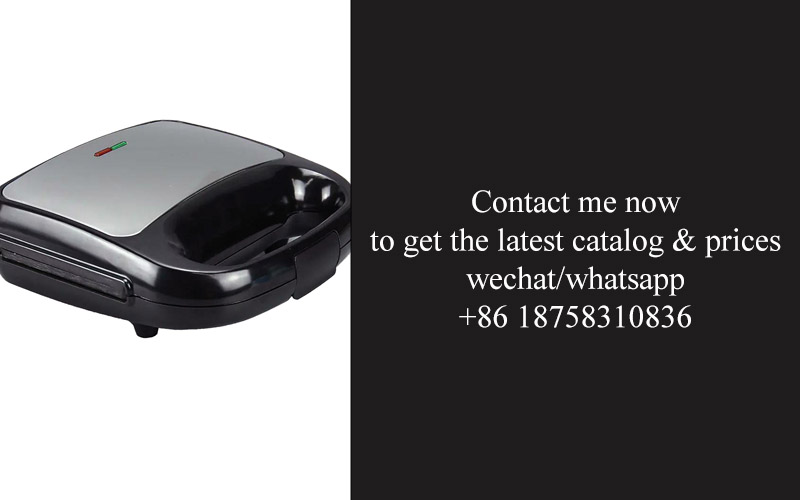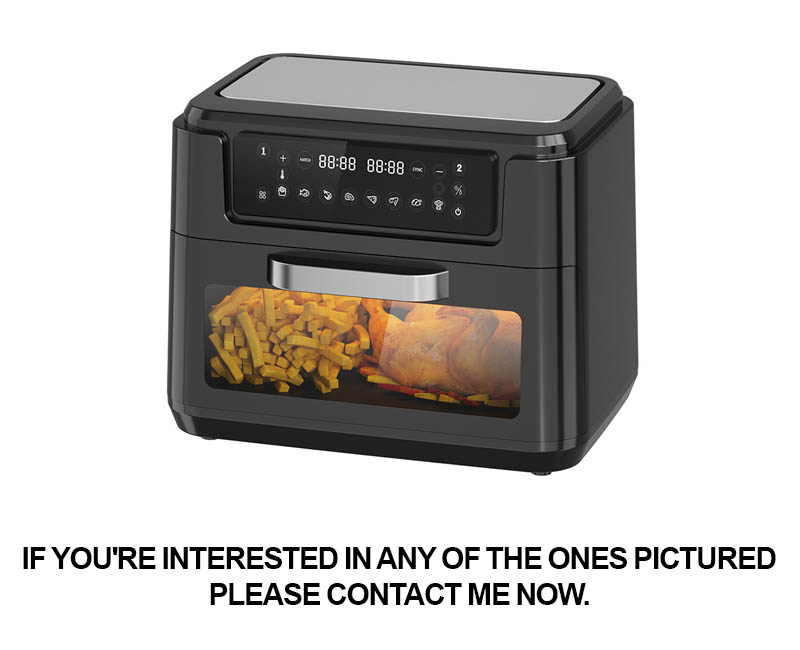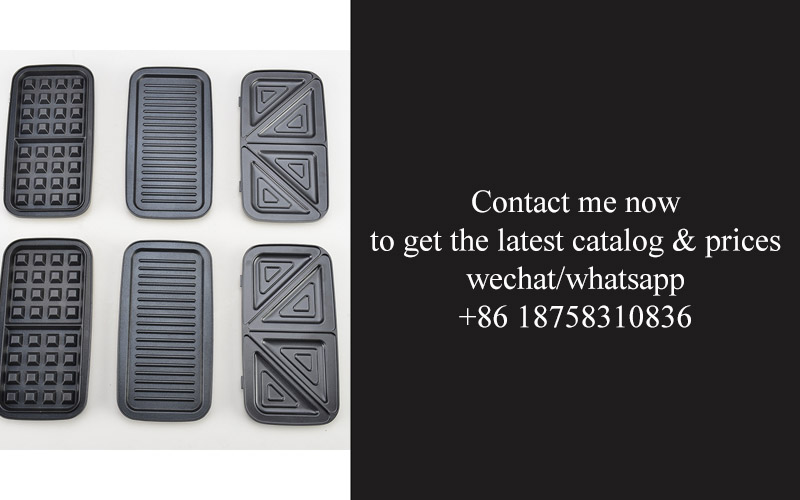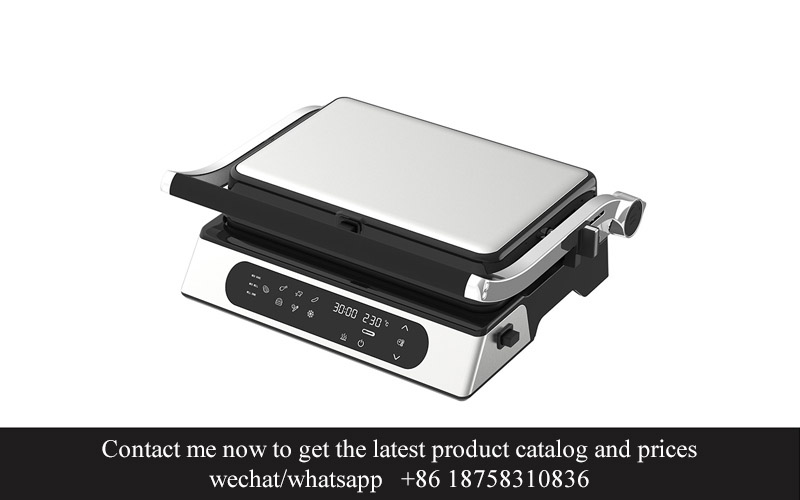Address
304 North Cardinal
St. Dorchester Center, MA 02124
Work Hours
Monday to Friday: 7AM - 7PM
Weekend: 10AM - 5PM
Address
304 North Cardinal
St. Dorchester Center, MA 02124
Work Hours
Monday to Friday: 7AM - 7PM
Weekend: 10AM - 5PM

In a world where technology and convenience meet culinary desires, the kitchen appliance industry continues to evolve at a rapid pace. Central to this transformation is the sandwich plate, a key component in modern cooking appliances. As innovations in integrated metal stamping push the boundaries of design and functionality, we delve into the fascinating world of these advancements, exploring how they are reshaping the landscape of kitchen appliances and setting the stage for future trends.
The evolution of kitchen appliances has brought about remarkable advancements, and among these, the rise of sandwich plate technology stands out as a game-changer. Once a mere component of kitchenware, the sandwich plate has transformed into a cornerstone of modern appliances, offering unparalleled functionality and versatility.
In the past, kitchen appliances were primarily focused on convenience and efficiency. The introduction of sandwich plates, which consist of multiple layers of metal, has revolutionized the way we approach cooking. These plates are not just for cooking food; they are integral to the design and performance of a wide range of appliances, from ovens to cooktops.
The process of creating sandwich plates involves precision engineering, where sheets of metal are laser-cut, stamped, and then bonded together to form a robust and heat-resistant structure. This method has allowed manufacturers to design plates with intricate patterns and varying thicknesses, tailored to specific cooking needs.
As sandwich plate technology has advanced, so has its application across various kitchen appliances. For instance, in induction cooktops, sandwich plates act as the cooking surface, providing a responsive and efficient way to heat pots and pans. The magnetic fields generated by the cooktop interact with the ferrous material of the plate, ensuring quick and even heating.
The rise of sandwich plate technology can be attributed to several factors. First, there’s the increasing demand for smart kitchen appliances that not only save time but also offer a superior cooking experience. Sandwich plates enable these appliances to maintain consistent heat distribution, which is crucial for delicate recipes that require precise temperature control.
Second, the versatility of sandwich plates is a major draw. They can be designed with different surface textures to accommodate a variety of cooking techniques, from searing to simmering. This adaptability has made them a favorite among professional chefs and home cooks alike.
Moreover, the use of integrated metal stamping in the production of sandwich plates has led to significant improvements in durability and thermal efficiency. The multi-layered construction ensures that the plates can withstand high temperatures without warping or deforming, which was a common issue with older single-layer plates.
In recent years, there has been a surge in eco-friendly kitchen appliances, and sandwich plates have played a crucial role in this trend. The materials used in sandwich plates are not only recyclable but also contribute to energy savings during operation. This has made them a preferred choice for environmentally conscious consumers.
The design of sandwich plates has also become more sophisticated. Advanced stamping techniques have allowed for the creation of plates with integrated heating elements, making them a key component in smart kitchen systems. These systems can be controlled via smartphone apps, allowing users to preheat plates, monitor cooking times, and even lock in the perfect setting for their specific recipe.
Another significant aspect of the rise of sandwich plate technology is its impact on kitchen aesthetics. Modern appliances with sleek, integrated sandwich plates not only enhance the visual appeal of kitchen countertops but also contribute to a cohesive and sophisticated look.
Looking ahead, the future of sandwich plate technology seems bright. Ongoing research and development are focused on further improving heat transfer efficiency, durability, and even the ease of cleaning. Innovations such as self-cleaning functions and improved heat recovery systems are on the horizon, promising even more efficient and user-friendly kitchen appliances.
In conclusion, the rise of sandwich plate technology in kitchen appliances is a testament to the relentless pursuit of innovation. As consumers continue to seek out advanced, sustainable, and aesthetically pleasing appliances, sandwich plates are at the forefront of this culinary revolution, setting the stage for the kitchens of tomorrow.

In the realm of kitchen appliances, the advent of sandwich plate technology has brought about a revolution in design and functionality. Central to this transformation is the role of integrated metal stamping, a process that has become indispensable in crafting these innovative components.
This technique involves the use of precision machinery to form metal sheets into complex shapes, creating the sandwich plates that are at the heart of many modern kitchen appliances. The stamping process is not just about shaping metal; it’s a cornerstone of efficiency and quality that has reshaped the landscape of kitchen appliance manufacturing.
The precision achieved through integrated metal stamping is unparalleled. It allows for the creation of intricate patterns and shapes that are not only visually appealing but also highly functional. The ability to stamp metal accurately means that sandwich plates can be designed with specific features that enhance the performance of appliances, whether it’s a refrigerator, oven, or even a countertop appliance.
One of the key advantages of this process is its scalability. Whether producing a few units for a niche market or millions for a mass-market product, integrated metal stamping maintains consistency in quality. This scalability is crucial in meeting the demands of different market segments, from high-end luxury kitchens to more budget-conscious households.
The integration aspect of the process is particularly noteworthy. By combining various metal stamping operations into a single process, manufacturers can streamline production, reduce waste, and lower costs. This integration not only optimizes the manufacturing line but also ensures that the final product is robust and free from defects.
The materials used in integrated metal stamping are also a testament to its versatility. From stainless steel to aluminum, the range of metals that can be stamped opens up a world of possibilities. Each material brings its own set of benefits, from durability and strength to corrosion resistance and lightweight properties, allowing engineers to tailor the sandwich plates to the specific needs of the appliance.
In terms of sustainability, integrated metal stamping is a green choice. The precision of the process minimizes material waste, and the use of recyclable metals ensures that the production process is environmentally friendly. This eco-conscious approach resonates with consumers who are increasingly looking for sustainable options in their appliances.
The design freedom offered by integrated metal stamping is a game-changer. Engineers can create sandwich plates with varying thicknesses, contours, and even incorporate integrated cooling systems or other technological innovations directly into the metal structure. This not only saves space but also improves the overall efficiency of the appliance.
Moreover, the process allows for the creation of sandwich plates with superior heat distribution capabilities. In appliances like ovens and cooktops, this is crucial for even cooking and reducing energy consumption. The ability to stamp metal with precise thermal properties ensures that the appliance performs optimally, regardless of the cooking task at hand.
As kitchen appliances continue to evolve, the role of integrated metal stamping will only grow more significant. It’s a technology that has adapted to the changing landscape of consumer needs and preferences, offering solutions that are both innovative and practical.
From the development of advanced cooling systems in refrigerators to the creation of multifunctional cooktops, integrated metal stamping is the backbone of these advancements. It’s a testament to human ingenuity and the endless possibilities that lie at the intersection of metalworking and kitchen appliance design.
In conclusion, integrated metal stamping is not just a process; it’s a cornerstone of modern kitchen appliance innovation. Its precision, scalability, design freedom, and sustainability make it an essential tool in the hands of engineers and manufacturers looking to push the boundaries of what’s possible in the kitchen.

The evolution of kitchen appliances has always been driven by innovation, and the advent of integrated metal stamping for sandwich plates is no exception. This cutting-edge technology has revolutionized the way we think about cooking surfaces, offering a blend of functionality, durability, and design that has become a game-changer in the industry.
In the heart of this innovation lies the sandwich plate itself—a marvel of modern engineering that combines multiple layers of metal, creating a robust and versatile cooking surface. The process of integrated metal stamping is what makes this possible, allowing manufacturers to craft these plates with precision and efficiency.
Precision Engineering at Its BestThe integrated metal stamping process begins with a detailed design, often utilizing computer-aided design (CAD) software. This allows engineers to create intricate patterns and shapes that are then transferred onto sheets of metal. The sheets are then fed into a stamping press, where they are subjected to high pressure, which shapes the metal into the desired form. This precision ensures that each sandwich plate is uniform in thickness and design, which is crucial for even heat distribution and long-lasting performance.
Enhanced Heat DistributionOne of the standout features of integrated metal stamping is its ability to create sandwich plates with unique heat-distributing properties. The multi-layered construction allows for better thermal conductivity, which means the heat is distributed more evenly across the plate. This not only improves cooking efficiency but also prevents hot spots that can burn delicate foods or create uneven browning.
Lightweight and StrongTraditionally, cooking surfaces were heavy and bulky, but the advancements in integrated metal stamping have changed that. The stamping process enables the creation of thinner, lighter plates without compromising on strength. This not only makes the appliances more portable and user-friendly but also contributes to energy efficiency, as less material is required to achieve the same thermal performance.
Customization and Design FlexibilityThe versatility of integrated metal stamping allows for a wide range of designs and finishes. Manufacturers can create plates with various textures, patterns, and even incorporate antimicrobial properties into the metal layers. This level of customization not only caters to aesthetic preferences but also addresses specific cooking needs, such as non-stick surfaces or induction-compatible plates.
Environmental ConsiderationsIn an era where sustainability is paramount, the integrated metal stamping process offers environmental benefits as well. By reducing the amount of material needed to create a sandwich plate, manufacturers can minimize waste and lower the carbon footprint associated with production. Additionally, the longevity of these plates means fewer appliances end up in landfills, further reducing environmental impact.
Performance and SafetyThe high-quality metal used in the stamping process ensures that sandwich plates are not only durable but also safe to use. The materials are heat-resistant, corrosion-resistant, and can withstand the rigors of everyday cooking. This not only enhances the performance of the appliance but also provides peace of mind to the consumer.
Integration with Smart Kitchen AppliancesThe innovative nature of integrated metal stamping extends beyond traditional cooking surfaces. It has paved the way for the integration of these plates into smart kitchen appliances, where they can be controlled via apps and sensors. This technology is a testament to how far kitchen appliances have come and where they are headed, offering a glimpse into the future of culinary experiences.
Market ImpactThe introduction of integrated metal stamping for sandwich plates has had a significant impact on the market. It has allowed manufacturers to offer a wider range of products that cater to different consumer needs and preferences. This has spurred competition, leading to better products and more choices for consumers.
Future DevelopmentsLooking ahead, the potential for innovation in integrated metal stamping is vast. Advances in material science and production techniques could lead to even more efficient and sustainable cooking surfaces. The possibilities are endless, from plates that can adjust their cooking temperature to those that can be customized to individual cooking styles.
ConclusionThe innovation in integrated metal stamping for sandwich plates is a testament to human ingenuity and the relentless pursuit of better living. It has redefined what we expect from kitchen appliances, offering a blend of performance, design, and sustainability that is sure to shape the future of cooking.

In the realm of kitchen appliances, the design and durability of a product are paramount. This is especially true for sandwich plates, which are the backbone of many modern cooktops and stovetops. Let’s delve into how these two aspects are revolutionizing the industry.
The sleek, modern aesthetic of sandwich plates is a testament to the advanced design techniques employed in their creation. Engineers have meticulously crafted these plates to not only look impressive but also to seamlessly integrate into various kitchen layouts. The sleek profiles and smooth finishes of these plates are not just about aesthetics; they are also a reflection of the precision involved in their manufacturing process.
The materials used in the construction of sandwich plates are a blend of functionality and elegance. High-quality stainless steel is the go-to material for its resistance to corrosion and heat, ensuring that the plates maintain their structural integrity over time. The innovative sandwich construction, which layers multiple metals, adds an extra layer of durability. This not only enhances the life span of the plate but also provides a thermal barrier that improves cooking efficiency.
Durability is not just about the longevity of the product; it’s also about its ability to withstand the rigors of daily use. Sandwich plates are designed to be resilient against scratches, dents, and warping. The interlocking layers of metal in the sandwich construction act as a shock absorber, protecting the plate from damage caused by heavy pots and pans. This design feature is particularly beneficial in households where cooking is a frequent and vigorous activity.
One of the standout features of modern sandwich plates is their heat distribution capabilities. The evenness of heat across the plate is crucial for achieving consistent cooking results. The innovative stamping process allows for intricate patterns and grooves that promote better heat conduction and retention. This means that the food cooks more evenly, reducing the risk of burning and ensuring that every dish is cooked to perfection.
The design of sandwich plates also takes into account the user’s experience. The ergonomic handles are not just a stylish addition; they are designed to provide a comfortable grip, reducing the risk of hand fatigue during prolonged cooking sessions. The non-slip surfaces and the right balance of weight contribute to a more enjoyable and safer cooking experience.
In terms of maintenance, the design of sandwich plates is a game-changer. The smooth, easy-to-clean surfaces make it a breeze to wipe away spills and residue. The non-reactive materials used in the construction mean that these plates are safe for use with a variety of cooking utensils and ingredients, without the risk of imparting flavors or colors.
Moreover, the design of sandwich plates is not static. Manufacturers are continuously exploring new materials and technologies to enhance the durability and performance of these plates. For instance, some are experimenting with ceramic coatings that offer additional scratch resistance and heat resistance, while others are looking into incorporating smart technology that can monitor and adjust heat distribution for optimal cooking results.
In conclusion, the design and durability of sandwich plates are at the forefront of innovation in the kitchen appliance industry. The combination of advanced materials, precision engineering, and thoughtful design ensures that these plates are not just durable but also a pleasure to use. As technology continues to evolve, we can expect even more sophisticated and user-friendly sandwich plates that will further elevate the cooking experience.

In the ever-evolving landscape of kitchen appliances, understanding the market insights and trends is crucial for staying ahead. Here’s a glimpse into the current dynamics shaping the industry:
The shift towards smart appliances has been a game-changer. Consumers are increasingly drawn to devices that offer connectivity, automation, and convenience. This trend has led to a surge in demand for integrated metal stamped sandwich plates that can be part of larger smart kitchen ecosystems.
Energy efficiency has become a key driver in the market. With rising energy costs and growing environmental concerns, appliances that are designed to consume less power are gaining popularity. Sandwich plates made through integrated metal stamping are not only durable but also often optimized for energy savings.
Sustainability is no longer just a buzzword; it’s a fundamental aspect of product development. Brands are under pressure to demonstrate eco-friendly practices, from sourcing materials to manufacturing processes. Integrated metal stamping, with its precision and the ability to recycle materials, aligns well with these sustainability goals.
The integration of health and wellness features into kitchen appliances is on the rise. Consumers are looking for products that can help them prepare healthier meals, whether through non-stick coatings that reduce the need for oil or plates that can measure the nutritional content of ingredients.
Customization is becoming more accessible. With the help of integrated metal stamping, manufacturers can create a wide variety of designs and configurations for sandwich plates, catering to the diverse tastes and preferences of consumers. This flexibility allows for niche markets to be targeted effectively.
There’s a growing interest in multifunctional appliances. The kitchen is no longer just a place for cooking; it’s a hub for entertaining and socializing. Sandwich plates that can double as serving platters or even as decorative elements are becoming a hit.
Globalization has expanded the reach of kitchen appliance brands. What was once a local phenomenon is now a global trend. This means that sandwich plates must be designed with international tastes in mind, offering a balance between cultural relevance and universal appeal.
Health and safety concerns are at the forefront. With the rise of foodborne illnesses, consumers are more cautious about the materials and finishes used in their kitchenware. Sandwich plates that undergo rigorous testing for safety standards are more likely to gain consumer trust.
The rise of e-commerce has changed the way consumers shop for kitchen appliances. They are looking for ease of purchase, fast delivery, and a seamless online experience. This has influenced the design of sandwich plates, with an emphasis on ease of handling and compatibility with online marketing strategies.
The integration of technology, such as touch controls and built-in thermometers, is becoming more common. These features not only enhance the user experience but also provide added value to the product, making it more appealing to tech-savvy consumers.
Finally, the market is becoming more competitive, with new entrants and established players constantly innovating. This competition drives innovation, leading to better products and more choices for consumers. Sandwich plates that can stand out in this crowded market through unique design, superior quality, and innovative features are the ones that will thrive.

In today’s fast-paced kitchen appliance industry, data-driven decisions are more crucial than ever. From market analysis to consumer behavior, the insights gleaned from data are shaping the direction of innovation and product development. Let’s delve into how this data is influencing the industry.
Consumer Behavior PatternsUnderstanding consumer behavior is pivotal in the kitchen appliance sector. Data analytics allow manufacturers to track usage patterns, preferences, and even the moments when appliances are most frequently used. For instance, data might reveal that certain features are highly valued during peak cooking times, leading to the development of appliances with enhanced functionalities.
Market Segmentation and TargetingMarket segmentation data helps companies identify niche markets and tailor their products accordingly. By analyzing demographics, purchasing habits, and lifestyle choices, appliance brands can create specialized offerings that resonate with specific consumer groups. This targeted approach not only increases sales but also fosters brand loyalty.
Product Development and InnovationData doesn’t just inform marketing strategies; it also drives product development. For instance, if data shows a growing demand for energy-efficient appliances, manufacturers can invest in research and development to create more sustainable options. Similarly, insights into consumer dissatisfaction with existing products can lead to the creation of entirely new categories or features.
Predictive AnalyticsThe use of predictive analytics in the kitchen appliance industry is on the rise. By analyzing historical data, companies can forecast future market trends and consumer needs. This foresight enables them to stay ahead of the competition and adapt their product lines proactively.
Customer Feedback and SatisfactionCustomer feedback is a goldmine of data that can guide product improvements. Surveys, reviews, and social media sentiment analysis provide actionable insights into what consumers like and what they don’t. This information is used to refine existing products and to develop new ones that better meet customer expectations.
Supply Chain OptimizationData-driven decisions also extend to the supply chain. By analyzing inventory levels, lead times, and supplier performance, companies can optimize their supply chain operations. This not only reduces costs but also ensures that products are available when and where consumers want them.
Regulatory ComplianceIn the kitchen appliance industry, compliance with various regulations is mandatory. Data analytics can help companies monitor regulatory changes and ensure that their products meet all necessary standards. This proactive approach minimizes the risk of recalls and maintains a company’s reputation.
Competitive AnalysisCompetitive analysis is a critical component of data-driven decision-making. By analyzing competitors’ products, pricing, and marketing strategies, companies can identify gaps in the market and position themselves accordingly. This competitive intelligence is invaluable for strategic planning and positioning.
Financial InsightsFinancial data provides a clear picture of a company’s performance and profitability. By analyzing sales figures, cost of goods sold, and return on investment, companies can make informed decisions about resource allocation, pricing strategies, and expansion plans.
Marketing and Advertising EffectivenessData analytics also play a crucial role in marketing and advertising. By tracking the performance of different campaigns, companies can allocate their marketing budgets more effectively and focus on the channels that yield the best results.
In conclusion, data-driven decisions are transforming the kitchen appliance industry. By harnessing the power of data, companies can better understand their customers, optimize their operations, and innovate in ways that resonate with the market. This shift towards data-centric decision-making is not just a trend; it’s the new norm in an industry that is increasingly driven by consumer needs and technological advancements.

In the realm of kitchen appliance innovation, there are several compelling case studies that showcase the success of integrated metal stamping for sandwich plates. These stories not only highlight the technological advancements but also underscore the impact on consumer experience and market reception.
A tale of sleek elegance, the premium line of countertop appliances by Gourmet Appliances featured a revolutionary sandwich plate designed with integrated metal stamping. The result was a sleek, modern look that effortlessly blended with contemporary kitchen aesthetics. Consumers were drawn to the plate’s sophisticated design, which was both functional and visually appealing, leading to a surge in sales.
Another standout success story comes from Kitchen Innovations, a brand known for its commitment to eco-friendly appliances. By employing integrated metal stamping, they developed a sandwich plate that was not only stylish but also made from recycled materials. This sustainable approach resonated with environmentally conscious consumers, resulting in a positive brand image and a significant market share boost.
The convenience and ease of use were at the heart of the success story of SmartChef Appliances. Their integrated metal stamped sandwich plate was designed with a unique hinge mechanism that allowed for a seamless open-and-close action. The innovative design was met with widespread acclaim, as it reduced the hassle of food preparation and cleaning. This case study underscores how simplicity and user-friendliness can be powerful selling points in the kitchen appliance market.
The rise of smart kitchen technology has also influenced the success of sandwich plate innovations. Homestars Kitchenware’s integrated metal stamped sandwich plates were equipped with smart features that allowed users to monitor and control cooking times remotely via a smartphone app. This integration of technology with kitchenware appealed to tech-savvy consumers who were looking for appliances that could enhance their daily routines.
A significant case study comes from Global Kitchens, a company that catered to a diverse range of markets worldwide. Their integrated metal stamped sandwich plates were customized for different regional tastes and cooking styles. For instance, in regions where thicker bread was the norm, the plates were designed with sturdier hinges to support the heavier weight. This localization strategy allowed Global Kitchens to tap into various markets successfully, showcasing the importance of understanding and adapting to local preferences.
The success of integrated metal stamping in sandwich plates can also be seen in the world of commercial kitchen appliances. Restaurant Equipment Solutions developed a commercial-grade sandwich plate that was durable and efficient, capable of handling high-volume orders without compromising on quality. This case study illustrates how the right application of technology can lead to a product that stands up to the demands of a busy kitchen environment.
One cannot overlook the success of EcoBaker Appliances, which introduced a sandwich plate that was not only made from recycled materials but also had an energy-efficient heating element. This eco-friendly design not only appealed to consumers looking for sustainable solutions but also helped the brand to establish a strong presence in the health-conscious market segment.
In the world of kitchen appliances, these case studies are more than just stories of success—they are testament to the power of innovation, design, and market research. From aesthetic appeal to practicality, these examples demonstrate how integrated metal stamping has transformed the sandwich plate from a simple kitchen component into a beacon of modern culinary innovation.

In today’s world, where sustainability and environmental consciousness are at the forefront of consumer concerns, the environmental angle in the kitchen appliance industry, particularly with integrated metal stamping for sandwich plates, cannot be overlooked. Here’s an exploration of how these factors intertwine:
The materials used in the production of kitchen appliances, including sandwich plates, have a significant impact on the environment. Traditional manufacturing processes often involve materials that are energy-intensive to produce and can be harmful to the planet. However, with integrated metal stamping, the use of metal alloys that are recyclable and durable is becoming more prevalent. These materials not only reduce the carbon footprint but also ensure that the product has a longer lifecycle, minimizing waste and the need for frequent replacements.
The manufacturing process itself plays a crucial role in environmental considerations. Integrated metal stamping is a highly efficient method that reduces material waste and energy consumption. By creating precision-formed parts with minimal material, manufacturers can optimize the use of resources. This efficiency is not just about saving costs; it’s about reducing the overall environmental impact of the product lifecycle.
Recycling and waste management are key components of the environmental angle. Sandwich plates made through integrated metal stamping are often designed with recycling in mind. The materials used are easier to recycle, and the stamping process minimizes the amount of waste generated during production. This approach aligns with the circular economy model, where resources are kept in use for as long as possible, extracting the maximum value from them while in use, and then recovering and regenerating products and materials at the end of each service life.
Energy efficiency is another critical aspect. Appliances that are built with sandwich plates stamped using integrated metal technology are often more energy-efficient. The precision of the stamping process allows for better insulation and heat distribution, leading to appliances that consume less energy while still providing the same level of performance. This not only saves money for consumers but also reduces the overall energy demand, which has a direct impact on greenhouse gas emissions.
Consumer demand for eco-friendly products is on the rise. As awareness of environmental issues grows, consumers are increasingly seeking out appliances that are produced with sustainability in mind. Companies that prioritize the environmental angle in their product development are likely to see a competitive advantage in the market. They can appeal to eco-conscious consumers and also position themselves as responsible corporate citizens.
Innovation in the design and manufacturing of kitchen appliances is not just about creating new features; it’s about creating a product that stands the test of time and is kind to the environment. For instance, the use of lightweight metals in sandwich plates can lead to appliances that are easier to transport, reducing the carbon footprint associated with logistics. This also means that appliances are more likely to be used in energy-efficient homes, further reducing their environmental impact.
Regulatory changes and certifications are also influencing the environmental angle. Governments and regulatory bodies around the world are implementing stricter standards for energy efficiency and environmental impact. Companies that adhere to these standards and obtain certifications like Energy Star or the EU’s Eco-label are more likely to gain market access and consumer trust.
The environmental angle in the kitchen appliance industry, especially with integrated metal stamping for sandwich plates, is a multifaceted approach that touches on every aspect of the product lifecycle. From the choice of materials to the manufacturing process, the distribution, and the end-of-life recycling, each step is an opportunity to make a positive impact on the environment. As the industry continues to evolve, we can expect to see even more innovative solutions that balance performance with sustainability.

The integration of technology into kitchen appliances has led to a surge in innovations, and the future of these devices looks promising. From smart connectivity to energy efficiency, the landscape is set to evolve significantly. Here’s a glimpse into what the future might hold for kitchen appliances:
In the realm of smart kitchen appliances, we’re witnessing a shift towards more intuitive and personalized experiences. Imagine a fridge that not only stores your food but also suggests recipes based on your dietary preferences and the contents of your pantry. Ovens that can be controlled remotely, kitchen islands with built-in touchscreens, and dishwashers that learn your cleaning habits—these are not just dreams but upcoming realities.
Energy efficiency is another key driver. As environmental concerns grow, so does the demand for appliances that consume less energy. The future will likely see appliances that harness renewable energy sources, such as solar or wind power, and incorporate smart systems to optimize energy usage. This not only benefits the consumer’s wallet but also contributes to a smaller carbon footprint.
Material advancements will play a crucial role. Lightweight, durable, and sustainable materials are being researched to replace traditional materials, reducing the weight of appliances and the environmental impact of their production. For instance, carbon fiber and biodegradable plastics are being explored for their potential to create kitchen appliances that are both strong and eco-friendly.
The rise of the Internet of Things (IoT) will further revolutionize the kitchen. Appliances will communicate with each other, allowing for seamless integration and automation. Imagine a scenario where your oven preheats before you arrive home, your coffee machine starts brewing as you wake up, and your fridge orders groceries before you run out. This interconnectedness promises a more efficient and convenient cooking experience.
Personalization is also on the rise. Customizable kitchen appliances that can be tailored to individual cooking styles and preferences are becoming more common. From the number of cooking modes to the color of the appliance, consumers will have more control over their kitchen environment.
Safety and health considerations are gaining traction. Kitchen appliances that can detect and prevent accidents, such as sharp objects falling onto hot surfaces or the risk of electrical fires, are on the horizon. Similarly, appliances that can help monitor health, like smart scales and blood pressure monitors integrated into kitchen countertops, are poised to become standard features.
Accessibility is another area where innovation is expected to flourish. Appliances designed for people with disabilities, offering voice control, Braille displays, and other assistive technologies, will become more widespread. This not only enhances the quality of life for those with special needs but also reflects a broader commitment to inclusivity.
As we look ahead, the kitchen is no longer just a place for cooking; it’s a hub of activity that reflects the technological advancements of our time. The future kitchen will be a blend of functionality, connectivity, and aesthetic appeal, catering to the diverse needs and preferences of consumers. From the smallest appliance to the largest piece of kitchen equipment, innovation will continue to shape the landscape, promising a future where the kitchen is not just a room but a dynamic and intelligent space.

In reflecting on the journey of kitchen appliances, one cannot help but marvel at the transformation that has taken place. The evolution from simple tools to sophisticated systems has been nothing short of remarkable. As we stand at the precipice of what could be the next technological leap, it’s clear that the future holds immense potential for innovation and efficiency.
The integration of smart technology has become a cornerstone in the kitchen appliance industry, offering users unparalleled convenience and control. From the early days of mechanical appliances to the current era of internet-connected devices, the kitchen has become a hub of connectivity and automation.
The rise of the eco-conscious consumer has also played a significant role in shaping the future of kitchen appliances. Sustainability is no longer just a buzzword; it’s a driving force behind the design and manufacturing processes. Companies are now focusing on materials that are not only durable but also environmentally friendly, such as recycled metals and biodegradable plastics.
In the realm of integrated metal stamping for sandwich plates, the precision and efficiency of this technology have opened new doors. The ability to create intricate designs while maintaining structural integrity has allowed for the development of appliances that are not only visually appealing but also highly functional.
The market insights and trends indicate a consumer base that values innovation and quality. Smart appliances with intuitive interfaces are becoming the norm, and the demand for energy-efficient models is on the rise. As data continues to drive decisions, we can expect to see even more personalized and efficient kitchen solutions emerging.
Success stories from various companies highlight the impact of these advancements. From the sleek, modern kitchen of a tech-savvy family to the energy-saving appliances in a commercial setting, the benefits of integrated metal stamping are clear. These case studies serve as a testament to the industry’s commitment to pushing boundaries and delivering results.
The environmental angle is equally crucial. As we strive to reduce our carbon footprint, the kitchen, with its myriad appliances, has become a focal point. The shift towards greener technologies is not just a trend; it’s a necessity. Companies are investing in research and development to create appliances that are not only efficient but also sustainable.
Looking ahead, the future of kitchen appliances seems bright. The integration of AI and machine learning promises to revolutionize the way we interact with our kitchen tools. Imagine a refrigerator that not only keeps your food fresh but also suggests recipes based on your dietary preferences and the ingredients you have on hand. The possibilities are virtually limitless.
The future of kitchen appliances will also be characterized by an increased focus on customization. With the ability to tailor appliances to individual needs and preferences, the kitchen could become a personal sanctuary of convenience and efficiency. The days of one-size-fits-all appliances are fading, making way for a world where every kitchen is uniquely equipped to meet its occupants’ demands.
In conclusion, the kitchen appliance industry is on the cusp of a new era. The fusion of advanced technology, environmental consciousness, and consumer demand is propelling the industry forward. As we continue to innovate and adapt, the kitchen of the future promises to be a place of wonder, where the art of cooking meets the science of living.